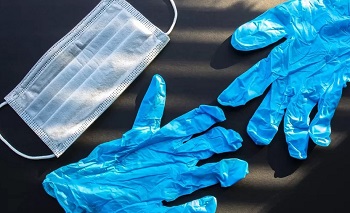BREAKING NEWS! Study Finds That COVID-19 Triggered Exposure Of Carcinogenic Phthalates To Many Via Masks And Gloves!
Thailand Medical News Team Aug 10, 2023 1 year, 7 months, 2 weeks, 6 days, 13 hours, 16 minutes ago
COVID-19 News: The outbreak of COVID-19, declared a pandemic by the World Health Organization in March 2020, dramatically altered human behavior and necessitated unprecedented public health measures to curtail its spread. Among the most crucial strategies employed were lockdowns, social distancing, travel restrictions, and the widespread adoption of personal protective equipment (PPE) including face masks, face shields, gloves, and hand sanitizers.

A comprehensive study conducted by researchers from Jazan University and the Research Center for Advanced Materials Science (RCAMS) at King Khalid University in Saudi Arabia, revealed the implications of COVID-19 preventive products, specifically PPE, on human exposure to phthalates a group of chemical compounds linked to various health concerns.
The demand for PPE soared in response to the pandemic, fostering a rapid global surge in production and consumption as covered in various past
COVID-19 News reports.
As PPE predominantly comprises plastic materials, it is often enriched with various plastic additives, including phthalate plasticizers. This study sought to investigate the presence and concentrations of six commonly used phthalates - DBP, BBP, DEHP, DnOP, DINP, and DIDP in different types of PPE collected during the early stages of the pandemic. The analysis was conducted using gas chromatography - mass spectrometry (GC-MS), ensuring data quality through certified reference materials, internal standards, procedural blanks, and replicate analyses.
The findings underscored that all tested face masks and face shields contained detectable levels of at least two of the target phthalates.
Notably, reusable cloth masks exhibited higher total phthalate contents compared to disposable masks, with concentrations spanning 0.60–942.60 µg/g. In some instances, certain masks displayed exceedingly high levels - 92.17 µg/g, 503.48 µg/g, and 942.60 µg/g - particularly those designed for children and adults.
The presence of thick plastisol prints on certain masks emerged as a potential source of elevated phthalate content, as phthalates leach out from the prints. The study also identified DBP, DEHP, and DINP as the major phthalates in plastisol-printed fabric sections and masks.
Disposable gloves, an essential component of PPE, also underwent scrutiny in the study. Gloves made from different plastic materials exhibited varying phthalate concentrations. Polyvinyl chloride (PVC) gloves, widely utilized due to their high phthalate content, contained concentrations ranging from 1.66–141,714 µg/g. While other glove types contained lower phthalate levels, vinyl gloves stood out for containing high proportions of phthalate alternatives such as DOIP and TBC.
Notably, DOIP and TBC, considered alternatives to phthalates, were detected in vinyl gloves, shedding light on potential complexities regarding the safety of non-phthalate alternatives.
Health risk assessment conducted in the study indicated that exposure to phthalates through inhalation and derm
al pathways from face masks and face shields was unlikely to lead to adverse health effects. Nonetheless, the long-duration use of such PPE could raise concerns, particularly for frontline workers.
Furthermore, a worrisome finding was the presence of two vinyl glove samples with phthalate content exceeding 11% and 14% (w/w) of the glove's weight, potentially amplifying the risk of cancer in humans.
While the study's health risk assessment focused primarily on human exposure, the authors also delved into the environmental impact of improper PPE disposal.
PPE waste, largely composed of synthetic polymers, contributed significantly to plastic pollution, exacerbating environmental concerns. The environmental ramifications encompassed wildlife entanglement, microplastic pollution, and the release of chemical constituents, including phthalate plasticizers and flame retardants, into the environment. The study urged proper disposal practices, heightened public awareness, and the development of biodegradable and sustainable PPE materials to mitigate these adverse effects.
In conclusion, the COVID-19 pandemic triggered an exponential surge in PPE production and usage, which consequently heightened human exposure to phthalates through these essential preventive products. Although health risk assessments suggested limited immediate dangers, the prolonged use of PPE, especially masks and gloves with elevated phthalate content, could potentially pose health risks over extended periods.
Equally alarming was the impact of improper PPE disposal on the environment, contributing to plastic pollution and chemical contamination. This study's multifaceted analysis underscores the need for balanced approaches that prioritize public health without neglecting environmental consequences, advocating for responsible PPE usage and disposal practices to safeguard both human health and the planet
The study findings were published in a peer reviewed journal Applied Sciences.
https://www.mdpi.com/2076-3417/13/16/9076
For the latest
COVID-19 News, keep on logging to Thailand Medical News.
